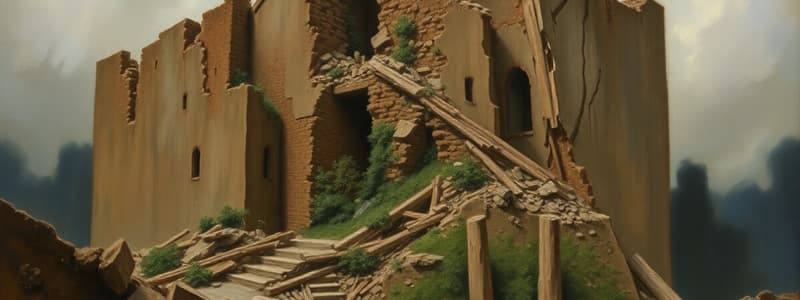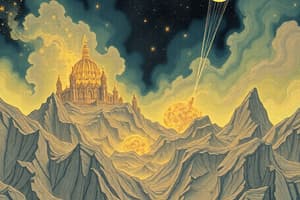Podcast
Questions and Answers
Which of the following is NOT a typical consequence of ground shaking during an earthquake?
Which of the following is NOT a typical consequence of ground shaking during an earthquake?
- Weakening of buildings and bridges.
- Increased agricultural productivity due to soil aeration. (correct)
- Disruption of communication networks.
- Fracturing of trees and damage to wildlife habitats.
The rupture of oil and chemical factories during ground shaking primarily leads to air pollution.
The rupture of oil and chemical factories during ground shaking primarily leads to air pollution.
False (B)
Name two types of infrastructure that are typically weakened by ground shaking.
Name two types of infrastructure that are typically weakened by ground shaking.
Buildings and Bridges
During the 2010 Port-au-Prince earthquake, the rupture of water pipes led to a significant __________.
During the 2010 Port-au-Prince earthquake, the rupture of water pipes led to a significant __________.
An earthquake causes widespread damage to infrastructure, including rupturing gas lines, collapsing buildings, and snapping powerlines. In addition to the direct physical destruction and immediate safety hazards, what is the most likely cascading effect that would critically impede rescue efforts and prolong the crisis in the immediate aftermath?
An earthquake causes widespread damage to infrastructure, including rupturing gas lines, collapsing buildings, and snapping powerlines. In addition to the direct physical destruction and immediate safety hazards, what is the most likely cascading effect that would critically impede rescue efforts and prolong the crisis in the immediate aftermath?
What is the primary cause of a tsunami?
What is the primary cause of a tsunami?
Besides direct flooding, which of the following is a significant way tsunamis damage coastal ecosystems?
Besides direct flooding, which of the following is a significant way tsunamis damage coastal ecosystems?
How do tsunamis most significantly disrupt essential services in affected areas?
How do tsunamis most significantly disrupt essential services in affected areas?
In addition to drowning, what is another major cause of injuries and death during a tsunami?
In addition to drowning, what is another major cause of injuries and death during a tsunami?
What was a key characteristic of the 2011 Tohoku, Japan tsunami that contributed to extensive damage?
What was a key characteristic of the 2011 Tohoku, Japan tsunami that contributed to extensive damage?
Which type of plate boundary is MOST commonly associated with major earthquake zones?
Which type of plate boundary is MOST commonly associated with major earthquake zones?
Intraplate earthquakes are more frequent and pose a greater overall global threat than earthquakes at plate boundaries.
Intraplate earthquakes are more frequent and pose a greater overall global threat than earthquakes at plate boundaries.
What geological feature is MOST often associated with intraplate volcanism?
What geological feature is MOST often associated with intraplate volcanism?
Subduction zone earthquakes are a significant trigger for ________.
Subduction zone earthquakes are a significant trigger for ________.
Match the plate boundary type with its associated tectonic hazard:
Match the plate boundary type with its associated tectonic hazard:
Which of the following factors DOES NOT influence the intensity of ground shaking during an earthquake?
Which of the following factors DOES NOT influence the intensity of ground shaking during an earthquake?
The recurrence interval of past seismic events, combined with historical seismicity, contributes MOST significantly to what type of assessment?
The recurrence interval of past seismic events, combined with historical seismicity, contributes MOST significantly to what type of assessment?
Explain the relationship between plate boundaries and the distribution of both earthquakes and volcanoes. Include specific examples of plate boundary types and their associated hazards.
Explain the relationship between plate boundaries and the distribution of both earthquakes and volcanoes. Include specific examples of plate boundary types and their associated hazards.
Flashcards
Ecosystem destruction
Ecosystem destruction
Ground shaking can destroy ecosystems by rupturing factories and damaging habitats.
Property damage
Property damage
Buildings, bridges, and roads can weaken or collapse, complicating rescue efforts after an earthquake.
Service disruption
Service disruption
Earthquakes can snap water and gas pipes, halting essential services and causing shortages.
Injuries and fatalities
Injuries and fatalities
Signup and view all the flashcards
2010 Haiti earthquake
2010 Haiti earthquake
Signup and view all the flashcards
Tsunami
Tsunami
Signup and view all the flashcards
Ecosystem damage
Ecosystem damage
Signup and view all the flashcards
Infrastructure destruction
Infrastructure destruction
Signup and view all the flashcards
2011 Tohoku Tsunami
2011 Tohoku Tsunami
Signup and view all the flashcards
Earthquake distribution
Earthquake distribution
Signup and view all the flashcards
Subduction zones
Subduction zones
Signup and view all the flashcards
Intraplate earthquakes
Intraplate earthquakes
Signup and view all the flashcards
Volcano distribution
Volcano distribution
Signup and view all the flashcards
Divergent plate boundaries
Divergent plate boundaries
Signup and view all the flashcards
Tsunami triggers
Tsunami triggers
Signup and view all the flashcards
Ground shaking factors
Ground shaking factors
Signup and view all the flashcards
Seismic hazard assessment
Seismic hazard assessment
Signup and view all the flashcards
Study Notes
Ground Shaking Effects
- Ecosystem Destruction: Earthquakes rupture oil and chemical factories, polluting land and water. They also fracture and uproot trees, causing widespread tree injury, death, and damage to wildlife habitats.
Property Damage
- Structural Damage: Earthquakes weaken buildings, bridges, roads, and railways, leading to their collapse. This makes rescue efforts difficult and disrupts the supply of emergency aid.
Service Disruptions
- Utility Failures: Earthquakes snap water and gas pipes, causing water shortages and disrupting gas supplies. Electricity and communication systems are also often disrupted, hindering tsunami warnings and TV broadcasts.
Injuries and Deaths
- Trapped People: Earthquakes trap people in collapsed buildings, resulting in injuries and deaths.
- Example: The 2010 Haiti earthquake (Mw 7.0) in Port-au-Prince caused significant pollution to surrounding areas of factories and debris-polluted rivers. More than 250,000 homes were destroyed, and over 220,000 people died. The earthquake also ruptured water pipes leading to water shortages.
Studying That Suits You
Use AI to generate personalized quizzes and flashcards to suit your learning preferences.




